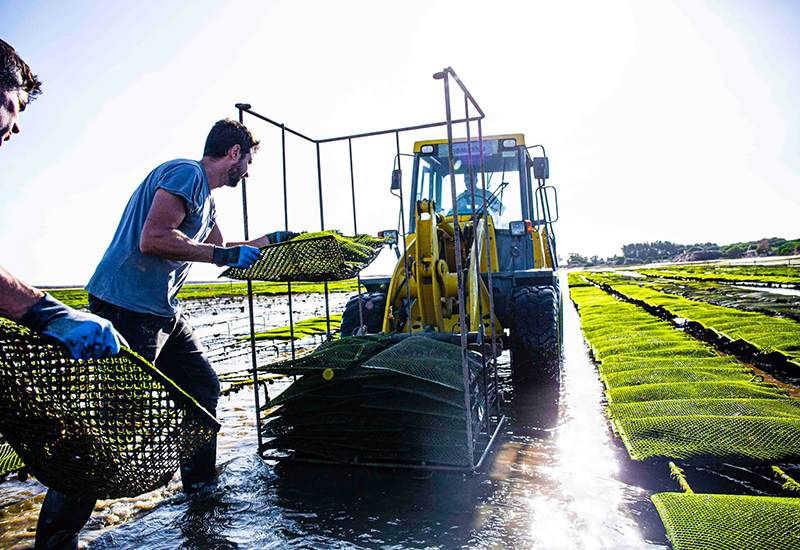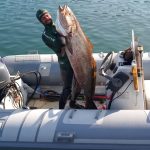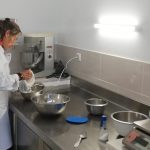Driving towards Vale de Lama from Mexilhoeira Grande along a windy road feels like you are on a journey to an isolated backwater. It is a million miles away from the tourist towns and beaches of the Algarve. As I leave the tarmac road and cross the railway tracks, there are numerous fish farms and I get my first glimpse of the alluring waters of the lagoon. I am arriving at high tide, so there is no clue that the warm tidal waters hold a myriad of treasures.
I take a sharp left up a track leading to a warehouse, and it is here that I start to get an impression of the abundant aquaculture in this area. At low tide, the Alvor tidal estuary reveals its secret. Seaweed-covered squares on metal legs emerge from the waters, marching in uniform rows across the lagoon. You might catch sight of a tractor moving between them or a worker whose job it is to turn the sacks. Oyster farming is an increasingly thriving industry in the Algarve and what I’m looking out on, is one of Vale de Lama’s most successful enterprises, Ostra Select.
I am here to meet oyster farmer Rui Ferreira, who has run this five-hectare site since 2000. Rui comes from a line of Algarve restaurant owners. His father owned Campimar restaurant in Porto do Mós, where Rui worked until it was sold when he was 19. He distributed Delta coffee in the area for a while, but his love of the sea and seafood drew him to the ocean. In 1994, he bought a fishing boat and dived, spearfishing to supply restaurants. In 1996, he started to work in Vale da Lama, helping a friend farm clams.
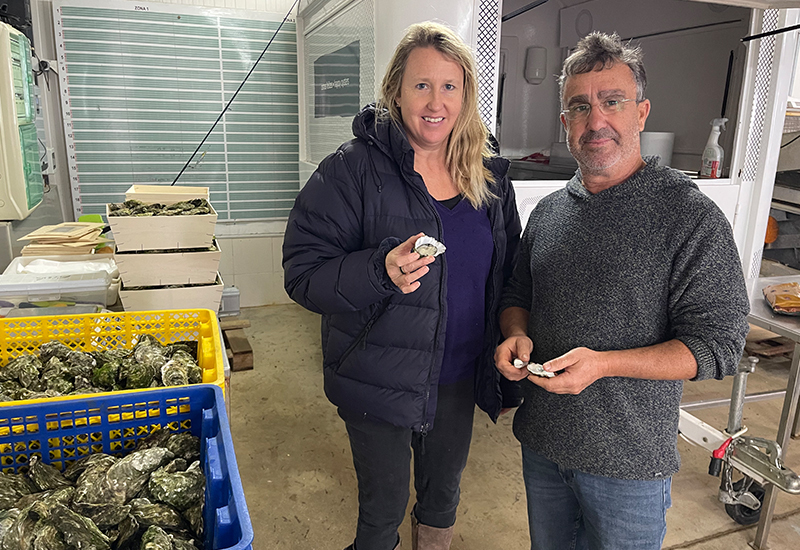
Rui still produces clams and razor clams, but he was a pioneer in foreseeing the future of oysters in the region. Although the oysters of the Rio Formosa have previously overshadowed their Alvor relatives, this estuary is the perfect location for an oyster farm. The Atlantic tides and constant water renewal provide the lagoon with rich phytoplankton for the bivalves to feed on. However, the water’s salinity means that oysters cannot breed in Alvor, so it is necessary to buy in the seeds, which are just 6 mm at this stage. Rui’s first attempts, however, were not successful. He bought millions of oyster seeds but admits he didn’t store them correctly, and 90% of them died. So, in 2000, Rui took a trip to France to learn the trade.
Originally, Rui bought the seeds from a producer in Arcachon. This is no longer necessary as a nursery, Bivalvia, has now been established in Faro. Once the oysters have settled in the Alvor estuary, the warm winters enable them to grow uniformly throughout the year. This makes the farm more productive than those in cold regions where oysters go into dormancy in winter. The Alvor oysters filter 50 litres of the salty, clean water of the tidal flats, growing twice as fast as their French cousins.
However, having the optimum growing conditions still doesn’t mean oyster farming is a walk in the park. Rui has 45,000 bags of oysters. When they arrive as seeds, they will be put in the sacks, and then they must be shaken daily to grow in a regular shape. The oysters are then graded in a machine and sorted in size. This is because the larger oysters will eat more food and starve the smaller ones. He also has to ensure that the larger ones don’t get too meaty, as this ruins the flavour. The up-river sacks receive more exposure to water and, therefore, more food, and grow more quickly, so the smallest are placed here.
Over two years, they mature into the minimum 65 g needed to make them commercially viable, and the sacks need to be turned every two weeks. Rui employs five workers and it is the job of one man to turn over the 45,000 sacks – a never-ending process. Rui is now experimenting with tubes that he attaches to the sacks and which turn the baskets as the tide rises and falls to make the process less labour-intensive.
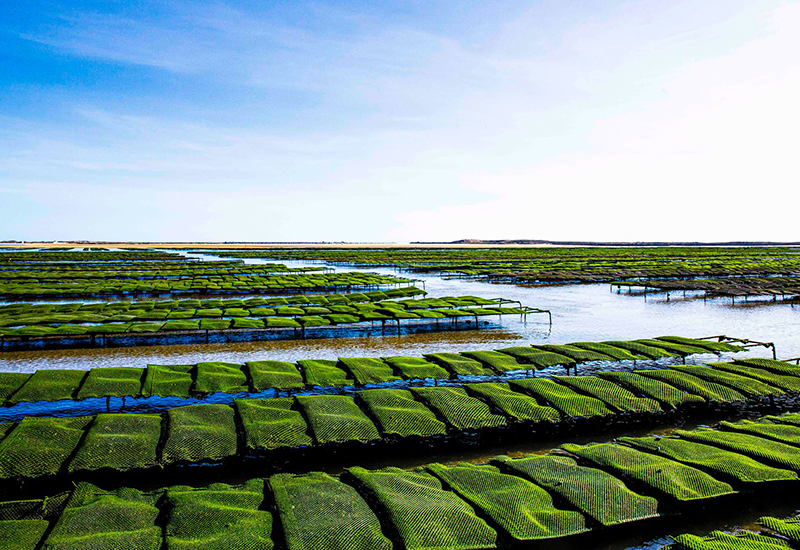

Is there a specific time when the Alvor oyster is in season? In the summer months, when the oysters are breeding and females are lactating, many oyster connoisseurs regard them as not so palatable. Rui has a genetically mutated sterile variety called a Triploid that maintains its meaty texture year-round to avoid this seasonality. For the rest of the year, Rui can sell the natural variety.
As it is impossible to own the actual seashore, establishing an aquaculture farm meant obtaining two licences. One permits the use of water resources (bank, bed and water) and is granted by the Port Administrations and Docapesca, S.A. The second permit is required to license the activity, which is the responsibility of the Directorate-General for Natural Resources, Safety and Maritime Services (DGRM).
When I first discovered this farm two years ago, Rui told me that he exported 80% of his produce to France. I am astonished to learn he no longer needs to export any. And that is the fantastic conclusion to this story. Not only has the industry flourished in the Algarve, but most of the oysters are now being consumed in the Algarve. This signals a fundamental change in Algarve gastronomy. Rui tells me, “Oysters are now the new trend. People always wanted to eat the Algarve clams, which is what the restaurants wanted, but now all restaurants serve oysters. I prefer to sell directly to the consumer now rather than exporting.” Rui is allowed this privilege after five years of water analysis. The IPMA classified the Alvor estuary as A grade in June 2002. This means that the Ostra Select oysters do not have to be cleaned with water and filters that eradicate the sea’s fresh taste.
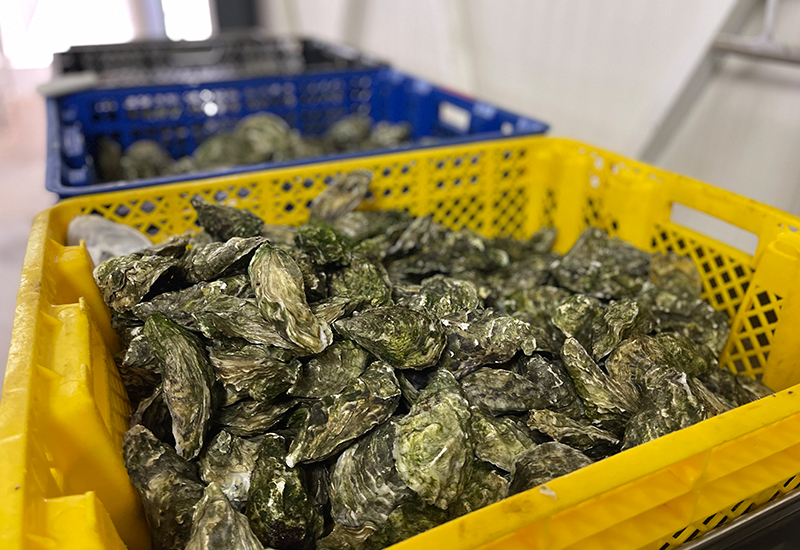
Now that the oyster is en-vogue, it can be enjoyed in all types of food outlets. The Pearl Food Trailer in Lagos Marina offers a new street food concept and serves fresh oysters in an informal setting. Rui’s cousin is the owner of Camilo Restaurant on Ponta de Piedade, where Ostra Selct have installed a truck selling oysters to hot beachgoers who cool down with fresh oysters and a glass of wine. In Portimão, Quinte Do Marisco offers fresh seafood in a friendly and informal setting.
Another part of Rui’s business, run by his son Miguel, is Oysters Experience, a mobile company which attends private functions. He is kept busy with events, weddings and food festivals. They invested in a “food bike” designed to offer a full oyster catering service anywhere, anytime. The bike is a one-stop oyster shop, supplying all your preferred condiments. The bike even has solar panels, giving it three hours of solar power to serve up a few hundred oysters. It is a deliciously fun way to entertain guests at any party.
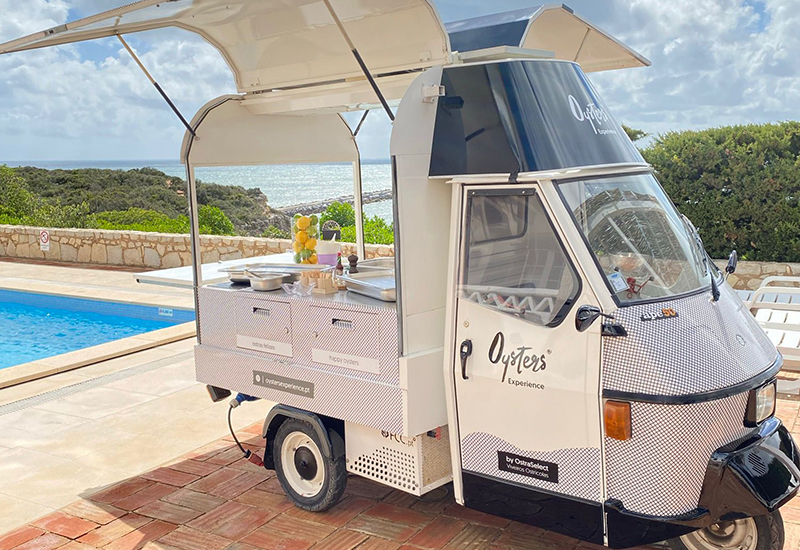

At the other end of the hierarchy, Michelin star chef João Oliveira brings clients to Rui’s farm for his Art of Tasting experience. His website says: “If you like oysters, this is without a doubt an unmissable experience. Chef João Oliveira will collect this exceptional product from the Ria de Alvor, incorporating his lagoon-flavoured dinner menu at his Michelin-starred restaurant, Vista.”
Rui is now preparing to welcome the Michelin Star classification committee to his farm at the end of February. They will be arriving for a tasting experience, which is a huge honour for Rui and the Alvor oyster. “People like to see where their food comes from now,” reflects Rui, “and people like to buy local and fresh.”
With Valentine’s Day approaching, you may want to surprise your loved one with an aperitif of a local oyster and a glass of something bubbly. Rich in vitamin D, copper, zinc, and manganese, and believed to be a natural aphrodisiac!
Before I left the farm, I had the privilege of sampling an oyster as fresh as it gets. From the counter of his factory, Rui prized open the oyster for me. The sweet and tender flesh slid down my throat with a delicious explosion of the sea. Delicious.
You, too, can buy your oysters by weight directly from the farm and view the stunning Alvor estuary simultaneously: +351 919 463 570
maps.app.goo.gl/xAUzf8hZL9dXd28EA
+351 968 082 051
+351 919 463 570
